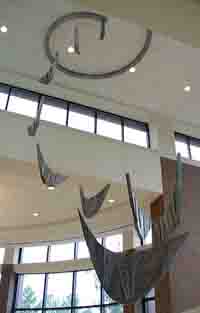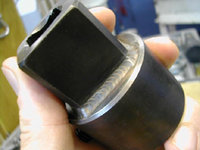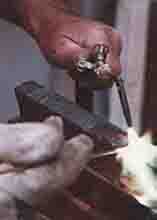You don’t have to be a professional TIG welder to repair aluminum professionally.
You can actually use Aluminum braze to repair cracks, holes, leaks, rivets, broken ears, threads or fabricate aluminum, cast aluminum, and cast iron quickly, easily, and stronger than new.
It’s not hard at all.
Many aluminum alloys can be brazed. Aluminum brazing alloys are used to provide an all-aluminum structure with excellent corrosion resistance and good strength and appearance.
The melting point of the brazing filler metal is relatively close to that of the material being joined. However, the base metal should not be melted; as a result, close temperate control is necessary. The brazing temperature required for aluminum assemblies is determined by the melting points of the base metal and the brazing filler metal.
Braze Aluminum Welding Basics
The process of brazing refers to the use of gas generated heat (800 degrees F), and an iron-free filler such as aluminum to join to different metals. The aluminum itself can also be used to replace a part of another metal that might have cracked or fallen off.
- Cost of Equipment: No argon gas, wire spool, gloves, shield, or electricity required.
- Portability: Stores easily, along with small torch.
- Skills Needed: Simple instructions virtually anyone can use. No flux, chemicals, or special cleaners required. 100% guaranteed.
- Danger: No high voltage electricity used.
- Oily Aluminum: Heli-arc boils aluminum and any impurities below the surface must be brought to the top and cleaned off.
- Thin Aluminum: Melts 500 degrees before aluminum.
- Different Alloys: Works with any alloy of aluminum or cast aluminum.
- Time Involved: Makes many repairs much quicker than conventional methods.
- Filling Holes: Instantly fills any size hole for threads much stronger than the original threads.
- Versatility: One product fills cracks or holes, rebuilds ears, seals leaks, or permanently bonds flat pieces.
Heat sources include a propane or MAPP gas, a turbo tip, or oxy-acetylene torch and special material.
Advantages of brazing over welding
Many new and used parts that can be repaired with braze aluminum and be made stronger than the original form. Examples include:
- Aluminum heads
- Cast iron heads
- A/C lines
- Timing covers manifolds
- Fuel tanks
- Wheels
- Aluminum Boats etc.
Brazing is a group of welding processes in which materials are joined by heating to a suitable temperature and by using a filler metal with a melting point above 840°F (449°C), but below that of the base metal.
The filler metal is distributed to the closely fitted surfaces of the joint by capillary action. The various brazing processes are described below.
Torch Brazing (TB)
Torch brazing is performed by heating the parts to be brazed with an oxyfuel gas torch or torches.
Depending upon the temperature and the amount of heat required, the fuel gas may be burned with air, compressed air, or oxygen.
Brazing filler metal may be pre-placed at the joint or fed from handheld filler metal.
Cleaning and fluxing are sometimes necessary.

Aluminum Brazing Filler Metals
Commercial brazing filler metals for aluminum alloys are aluminum base. These filler metals are available as wire or shim stock.
A convenient method of preplacing filler metal is by using a brazing sheet (an aluminum alloy base metal coated on one or both sides).
Heat treatable or core alloys composed mainly of manganese or magnesium are also used.
A third method of applying brazing filler metal is to use a paste mixture of flux and filler metal powder. Common aluminum brazing metals contain silicon as the melting point depressant with or without additions of zinc, copper, and magnesium.
Aluminum Brazing Flux
Aluminum braze flux is required in all aluminum brazing operations.
Aluminum brazing fluxes consist of various combinations of fluorides and chlorides and are supplied as a dry powder.
For torch and furnace brazing, the flux is mixed with water to make paste. This paste is brushed, sprayed, dipped, or flowed onto the entire area of the joint and brazing filler metal.
Torch and furnace brazing fluxes are quite active, may severely attack thin aluminum, and must be used with care.
In dip brazing, the bath consists of molten flux. Less active fluxes can be used in this application and thin components can be safely brazed.
Practice Metal Brazing Techniques
Materials Needed:
- Auto darkening welding helmet
- Carbon steel pipe
- Brazing metal rod such as aluminum
Aluminum Braze Instructions:
- Start by making sure that you have a safe environment to braze aluminum. This includes proper ventilation and a welding helmet.
- Next, purchase a small piece of carbon steel pipe.
- Place the pipe between 2 fire bricks, laid about 3/4″ from each other
- Get your oxyacetylene torch and set it to neutral
- Start on the side of the steel pipe that is most comfortable for you (e.g; right handed people start on the right side). Use the torch to melt off a piece of the filler rod onto the end of the pipe.Note: After placing an initial amount of melted rod on the end of the steel pipe, use the molten metal itself to melt more of the rod. Do not use the torch flame. If you see white smoke rising from the molten metal, it means that you may get a poor weld
If you want to cool the pipe and try again, pick up with a tool and place in water a process called quenching a weld (water will weaken a weld, but for practice it is fine).
Here’s a short 3 minute video:

Brazed Joint Design
Brazed joints should be of lap, flange, lock seam, or tee type. Learn more about these joints here.
Butt or scarf joints are not generally recommended.
Tee joints allow for excellent capillary flow and the formation of reinforcing fillets on both sides of the joint.
For maximum efficiency, lap joints should have an overlap of at least twice the thickness of the thinnest joint member. An overlap greater than 1/4 in. (6.4 mm) may lead to voids or flux inclusions. In this case, the use of straight grooves or knurls in the direction of brazing filler metal flow is beneficial.
Closed assemblies should allow easy escape of gases and in dip brazing easy entry as well as drainage of flux.
Good design for long laps requires that brazing filler metal flows in one direction only for maximum joint soundness. The joint design must also permit complete post braze flux removal.
Brazing Fixtures
Whenever possible, parts should be designed to be self-jigging. When using fixtures, differential expansion can occur between the assembly and the fixture to distort the parts.
Stainless steel or Inconel springs are often used with fixtures to accommodate differences in expansion. Fixture material can be mild steel or stainless steel. However, for repetitive furnace brazing operations and for dip brazing to avoid flux bath contamination, fixtures of nickel, Inconel, or aluminum-coated steel are preferred.
Precleaning
Pre-cleaning is essential for the production of strong, leak-tight, brazed joints. Vapor or solvent cleaning will usually be adequate for the non-heat treatable alloys. For heat-treatable alloys, however, chemical cleaning or manual cleaning with a wire brush or sandpaper is necessary to remove the thicker oxide film.
Furnace Brazing
Furnace brazing is performed in gas, oil, or electrically heated furnaces. Temperature regulation within 5ºF (2.8ºC) is necessary to secure consistent results.
Continuous circulation of the furnace atmosphere is desirable since it reduces brazing time and results in more uniform heating. Products of combustion in the furnace can be detrimental to brazing and ultimate serviceability of brazed assemblies in the heat treatable alloys.
Aluminum Torch Brazing
Torch brazing differs from furnace brazing in that heat is localized.
Heat is applied to the part until the flux and brazing filler metal melt and wet the surfaces of the base metal.
The process resembles gas welding except that the brazing filler metal is more fluid and flows by capillary action.
Torch brazing is often used for the attachment of fittings to previously weld or furnace-brazed assemblies, joining of return bends, and similar applications.
Dip Brazing
In aluminum dip brazing operations, a large amount of molten flux is held in a ceramic pot at the dip brazing temperature.
Dip brazing pots are heated internally by direct resistance heating.
Low voltage, high current transformers supply alternating current to pure nickel, nickel alloy, or carbon electrodes immersed in the bath. Such pots are generally lined with high alumina content fire brick and a refractory mortar.
WARNING
The acid solutions used to remove aluminum welding and brazing fluxes after welding or brazing are toxic and highly corrosive. Goggles, rubber gloves, and rubber aprons must be worn when handling the acids and solutions. Do not inhale fumes. When spilled on the body or clothing, wash immediately with large quantities of cold water. Seek medical attention.
Never pour water into acid when preparing solutions: instead, pour acid into water. Always mix acid and water slowly. These operations should only be performed in well-ventilated areas.
Post brazing Cleaning
It is always necessary to clean the brazed assemblies, since brazing fluxes accelerate corrosion if left on the parts.
The most satisfactory way of removing the major portion of the flux is to immerse the hot parts in boiling water as soon as possible after the brazing alloy has solidified.
The steam formed removes a major amount of residual flux. If distortion from quenching is a problem, the part should be allowed to cool in air before being immersed in boiling water.
The remaining flux may be removed by a dip in concentrated nitric acid for 5 to 15 minutes. The acid is removed with a water rinse, preferably in boiling water in order to accelerate drying.
An alternate cleaning method is to dip the parts for 5 to 10 minutes in a 10 percent nitric plus 0.25 percent hydrofluoric acid solution at room temperature. This treatment is also followed by a hot water rinse.
For brazed assemblies consisting of sections thinner than 0.010 in. (0.254 mm), and parts where maximum resistance to corrosion is important. A common treatment is to immerse in hot water followed by a dip in a solution of 10 percent nitric acid and 10 percent sodium dichromate for 5 to 10 minutes. This is followed by a hot water rinse. When the parts emerge from the hot water rinse they are immediately dried by forced hot air to prevent staining.
Other Aluminium Guides
Welding Aluminum – A Complete Guide

